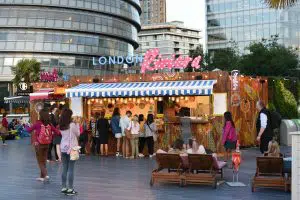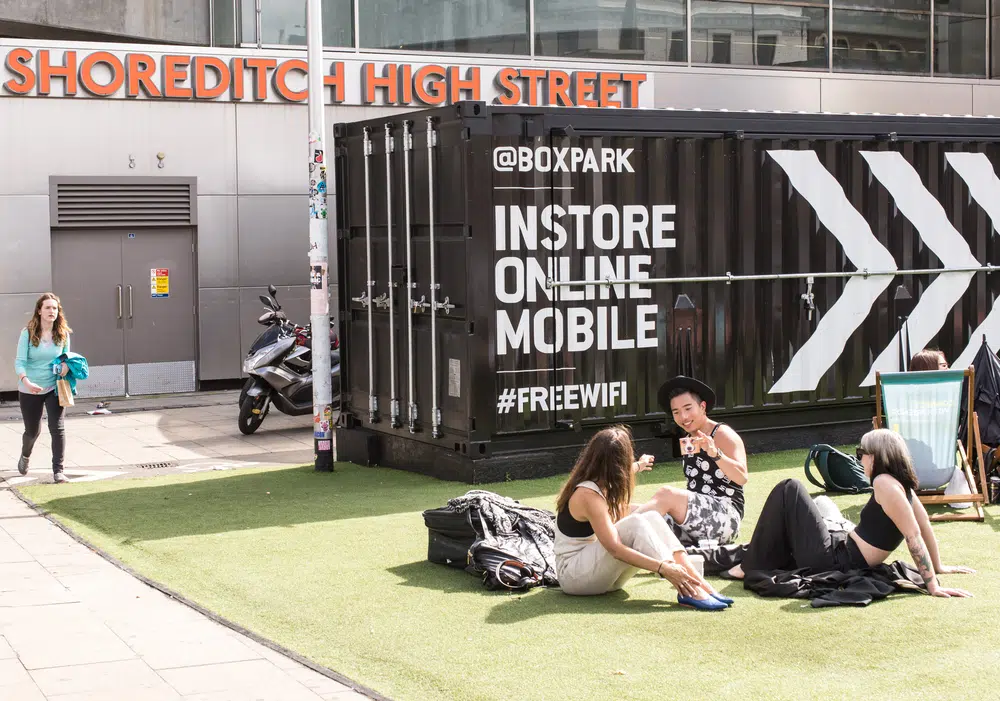
Despite the convenience of online shopping, people yearn to reconnect with brands and each other in a tangible, physical setting.
Interestingly, the pandemic’s aftermath has left a surplus of available retail space, and commercial rent prices have plummeted. This creates an advantageous market for retailers and brands keen on establishing a physical presence for their businesses.
According to Appear Here’s research, the US, UK, and France have seen a staggering 125% surge in available retail space listed between June and August 2020. Landlords are now eager to fill their vacant spaces, leading them to reduce prices and offer more flexible lease terms.
Anticipating a surge in low-budget, short-term, and quick-install pop-ups, we are here to assist you in planning your venture. We will cover essential aspects such as cost and marketing strategies, while also showcasing exemplary brands at the forefront of the trending pop-up experiences in this post-pandemic world. Exciting times await for those ready to seize this promising opportunity
What is a pop-up shop?
A pop-up shop is a temporary retail space that appears for a short period, typically ranging from a few days to a few months. Unlike traditional brick-and-mortar stores, pop-ups are designed to be transient and offer a unique and engaging shopping experience to consumers. These temporary shops can be set up in various locations, such as empty storefronts, event spaces, or even mobile structures.
Pop-up shops are often used by brands and retailers to create buzz, test new products or markets, and interact directly with customers in a physical environment. Due to their temporary nature, pop-ups often rely on innovative marketing strategies and limited-time offers to attract customers and make a lasting impression.
The concept of pop-up shops has gained popularity due to their ability to capitalize on changing consumer behaviors, create a sense of urgency, and provide a refreshing twist to traditional retail experiences.
History of “pop-up” retail
The history of “pop-up” retail can be traced back to the 1990s, with roots in the underground and guerrilla marketing movements. The concept emerged as a response to the rapidly changing retail landscape and consumer behaviors.
The term “pop-up” itself gained prominence in the early 2000s. One of the earliest instances of pop-up shops can be attributed to Japanese fashion brand Comme des Garçons, which in 2004 launched “guerrilla stores” in various cities, featuring limited-edition collections and unconventional store designs. This approach sparked interest and set the stage for pop-ups to become a global phenomenon.
Over the years, pop-up shops have evolved from being experimental marketing tactics to a mainstream strategy embraced by established brands, startups, and even e-commerce giants.
Their success lies in offering exclusive experiences, generating buzz, and fostering a sense of urgency among consumers, proving that temporary and creative retail spaces can be highly effective in capturing the attention of modern shoppers.
What are the benefits of a pop-up shop?
The benefits of a pop-up shop are numerous and compelling for both retailers and consumers. For retailers, pop-ups offer a unique opportunity to reach a new audience in high-traffic locations, helping to expand their customer base and build brand awareness.
These temporary retail spaces allow brands to create immersive and engaging experiences, strengthening customer relationships and fostering brand loyalty.
Customer benefits
- Increased shopping variety and excitement in retail stores, high streets, and shopping malls.
- Opportunity to explore and discover new brands and products in a unique and engaging setting.
- Access to exclusive discounts, giveaways, and event-specific concessions, enhancing customer experience and engagement.
Brand benefits
- Expanded reach and exposure to a new audience in high-traffic locations.
- Ability to deliver immersive and memorable short-term experiences, reinforcing brand messages and building brand loyalty.
- Valuable market research opportunities to gain insights into target customers and guide future business strategies.
- Effective sales strategies, such as clearing stock or driving sales through limited-time offers and a sense of urgency.
Landlord benefits
- Filling vacant storefronts that would otherwise remain empty, reducing potential loss of revenue.
- Attracting excitement and innovation to the street and neighborhood, enhancing the overall appeal of the area.
- Generating buzz for the property and attracting potential long-term tenants through the temporary pop-up shops.
- Flexibility in offering short-term leases, allowing quick setup and accommodating various brand partners and concepts.
Who can open a pop-up shop?
Anyone can open a pop-up shop, as long as they have a product or service to offer and a suitable space to set up temporarily. Pop-up shops are accessible to a wide range of businesses, from large established brands to independent startups and local artisans.
The flexibility and lower investment required make pop-up shops an attractive option for entrepreneurs, online retailers looking to expand their reach, and established businesses wanting to test new concepts or locations.
Here are a few examples:
- Fashion – Pop-up shops cater to a wide spectrum of fashion enthusiasts, welcoming large High Street brands, independent designers, and local labels alike.
- Health and Beauty – Embracing the concept of pop-up shops becomes an ideal avenue for the health and beauty industry, offering the perfect platform for product launches, test events, and brand-building exercises.
- Art and Artists – Artists find great value in pop-up shops and galleries as they present an opportunity to showcase their collections and connect with potential buyers. The flexibility of pop-ups allows local artists to unleash their creativity, curating impactful and engaging display spaces.
- Online Retailers – Pop-up stores hold a special allure for digital-first online retailers and e-commerce brands seeking to broaden their horizons or venture into physical retail. The immersive offline experience offered by pop-ups proves invaluable, showcasing a dimension that the online realm can never fully replicate.
- Retailers with Existing Physical Presence – Established retailers with brick-and-mortar stores can leverage pop-up shops to experiment with novel geographies or fresh concepts. Opting for a six-month pop-up store minimises investment risks while providing a valuable testing ground before committing to more permanent ventures.
- Food and Beverage Providers – From delightful ice cream trucks to tantalising pop-up cafés and burger trucks, food and beverage vendors find pop-ups as an enticing pathway to expand their market reach and explore new audiences and culinary offerings in the realm of temporary restaurants.
Lastly, and of significant importance, pop-up shops serve as invaluable instruments for emerging small brands taking their first steps into the retail landscape. For those who have been showcasing their products at small markets or fairs and pondering their next move, a pop-up in a bustling area for a week or two, a couple of times a year, becomes a strategic move.
This enables them to gauge the market’s response to their brand, and by shifting locations, they can explore and experiment with different audiences, paving the way for informed and calculated growth.
Where are pop-ups found?
Pop-up shops are found in a wide array of locations, reflecting their versatility and adaptability. They have gained popularity across various countries, including the United States, Canada, China, Japan, Mexico, France, Germany, the United Kingdom, and Australia.
In recent times, the trend has also expanded in Asian cities like Shanghai, Singapore, Hong Kong, and Seoul. Major global cities such as New York, London, Los Angeles, Paris, Milan, Hong Kong, and Amsterdam serve as prominent hubs for pop-up shops, boasting a diverse range of options on platforms like Storefront.
While traditional retail storefronts frequently host pop-ups, the appeal of these temporary retail spaces lies in their ability to foster creativity and innovation, leading to their appearance in unusual venues like staircases, halls, lofts, and warehouses.
Additionally, there is a growing trend of pop-up retail spaces within shopping malls and centers, offering brands an opportunity to tap into high foot traffic and assess competitors directly.
The wide variety of locations where pop-ups can be found reflects their adaptability to diverse environments, enriching the retail landscape and captivating consumers in novel and exciting ways
How much does a pop-up shop cost?
The cost of a pop-up shop can vary widely depending on several factors. One of the main determinants is the location and type of space chosen for the pop-up. High-traffic areas or popular neighborhoods may command higher rents.
The duration of the pop-up also influences the cost, with longer leases typically requiring higher fees. Additional expenses may include obtaining permits, licenses, insurance, and marketing materials. The cost of setting up the physical space, including interior design, fixtures, and decorations, must also be considered.
However, compared to traditional brick-and-mortar stores, pop-up shops generally offer a more cost-effective option with lower investment and reduced risk. Entrepreneurs can find useful insights and tailored estimations by researching specialized resources on the cost of pop-up shops.
To delve deeper into the expenses associated with a “pop-up” shop, explore the comprehensive insights provided in this enlightening article: ‘How much does a pop-up shop cost?’.
How to find the perfect pop-up shop location
Finding the perfect pop-up shop location is a crucial step in ensuring the success of your temporary retail venture. The process involves careful consideration of various factors to align with your brand’s goals and target audience.
Finding the perfect pop-up shop location involves several key steps:
- Define your target audience and research areas with a high concentration of potential customers.
- Explore different neighborhoods and shopping districts to assess foot traffic and nearby attractions.
- Analyze the competition to identify gaps or opportunities in the market.
- Consider the type of space that aligns with your brand and merchandise.
- Evaluate the accessibility and visibility of each location.
To secure the ideal pop-up shop spot, follow these stages:
- Conduct site visits and inspections to assess each location’s suitability.
- Negotiate lease terms, including rent, duration, and additional costs.
- Obtain the necessary permits and licenses for operating a temporary retail space.
- Design and set up the interior layout and branding.
- Implement effective marketing and promotional strategies.
By following these steps and considering essential criteria, you can find the perfect pop-up shop location that aligns with your brand and attracts your target audience.
Pop-Up shop ideas
When brainstorming pop-up shop ideas, several factors come into play:
- Consider the type of products or services you want to offer to ensure alignment with your brand and target audience.
- Determine your budget for the space and inventory, as this will influence the size and location of your pop-up shop.
- Identify your target market to tailor your offerings and marketing strategies accordingly.
Once you have a clear idea of what you want to sell, the next step is to find a suitable location that matches your vision and budget. This could range from a vacant storefront or community center to a public park, each offering unique advantages.
With the space secured, focus on stocking it with inventory and setting up engaging displays. Creativity is key, especially if you have a limited budget. Utilize recycled materials or items you already possess to create eye-catching displays that resonate with your target customers.
By carefully considering these factors and making resourceful decisions, you can craft a compelling pop-up shop experience that captures the attention of your audience and drives success.
How to set up pop-up shop?
A pop-up shop presents an excellent opportunity to test new retail concepts or products while building brand awareness and creating excitement around your business. To ensure a successful pop-up shop, consider the following tips:
- Find the Right Location: Select a strategic and high-traffic location to attract potential customers and increase sales.
- Create a Visually Appealing Space: Design an eye-catching and unique space that sets you apart from competitors and draws customers in.
- Implement a Strong Marketing Plan: Develop a comprehensive marketing strategy to promote your pop-up shop and generate interest among your target audience.
- Offer a Great Product or Service: The quality of your offerings will ultimately drive sales and encourage customer loyalty.
By adhering to these guidelines, you can curate a seamless and thriving pop-up shop experience that leaves a lasting impression on both your business and your customers.
Renting a pop-up store
Renting a pop-up store involves securing a temporary retail space for a short period, typically ranging from a few days to a few months. This allows businesses to experiment with a physical presence, test new markets, launch products, or create unique brand experiences without the commitment and expenses associated with a long-term lease.
The process of renting a pop-up store typically involves the following steps:
- Research and Find a Suitable Space: Explore available pop-up spaces in desired locations, considering factors such as foot traffic, visibility, and suitability for your brand and products.
- Negotiate Lease Terms: Discuss lease terms with the property owner, including the duration of the rental, rent amount, security deposit, and any additional costs or fees.
- Obtain Necessary Permits and Insurance: Depending on local regulations, you may need to obtain permits or licenses to operate your pop-up shop. Additionally, consider obtaining liability insurance to protect your business during the rental period.
- Design and Set Up: Plan the layout and design of your pop-up store to create an attractive and engaging shopping experience for customers.
- Market and Promote: Develop a marketing strategy to promote your pop-up store, attract foot traffic, and generate interest among your target audience.
- Operate the Pop-Up Store: Once everything is set up, run your pop-up shop and provide exceptional customer experiences to maximize its success.
At the end of the rental period, you can either choose to extend the lease, move to a different location, or close the pop-up store depending on your business objectives and performance during the rental period. Renting a pop-up store offers flexibility and a cost-effective way to explore new opportunities in the retail landscape.
Frequently asked questions
Do you need planning permission for a pop-up shop?
No, Planning permission is not needed for use that does not continue for more than 28 days in a 12-month period. If the shop covers less than 150sq in an existing commercial space, it may be seen as a change of use – and you can simply notify the landlord. But anything bigger is likely to need planning permission.
How successful are pop-up stores?
Pop up stores are 46% reported an increase in sales, a 51% rise in market visibility, 66% greater brand awareness and a 46% spike in social-media engagement.
Conclusion
In conclusion, pop-up shops have emerged as powerful and versatile tools for businesses across various industries. These temporary retail spaces offer unique benefits to both retailers and customers. For retailers, pop-up shops provide an opportunity to test new concepts, expand brand reach, and create buzz around their business.
They are cost-effective alternatives to traditional brick-and-mortar stores, offering reduced investment and lower risk. On the other hand, customers enjoy diverse and engaging shopping experiences, exploring new brands and products while relishing exclusive discounts and promotions. From fashion to health and beauty, art, online retailers, and even food and beverage providers, pop-up shops cater to a wide range of businesses looking to make a splash in the retail landscape.
By considering key factors such as location, target market, and product offerings, businesses can set up successful pop-up shops, creating lasting impressions and driving growth in the dynamic world of retail.
Lee Jones is a seasoned Business Finance Specialist with over two decades of invaluable experience in the financial sector. With a keen eye for market trends and a passion for helping businesses thrive, Lee has become a trusted advisor to countless organizations seeking to navigate the complexities of finance.


